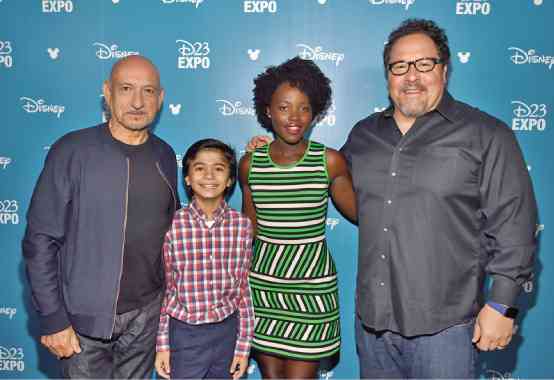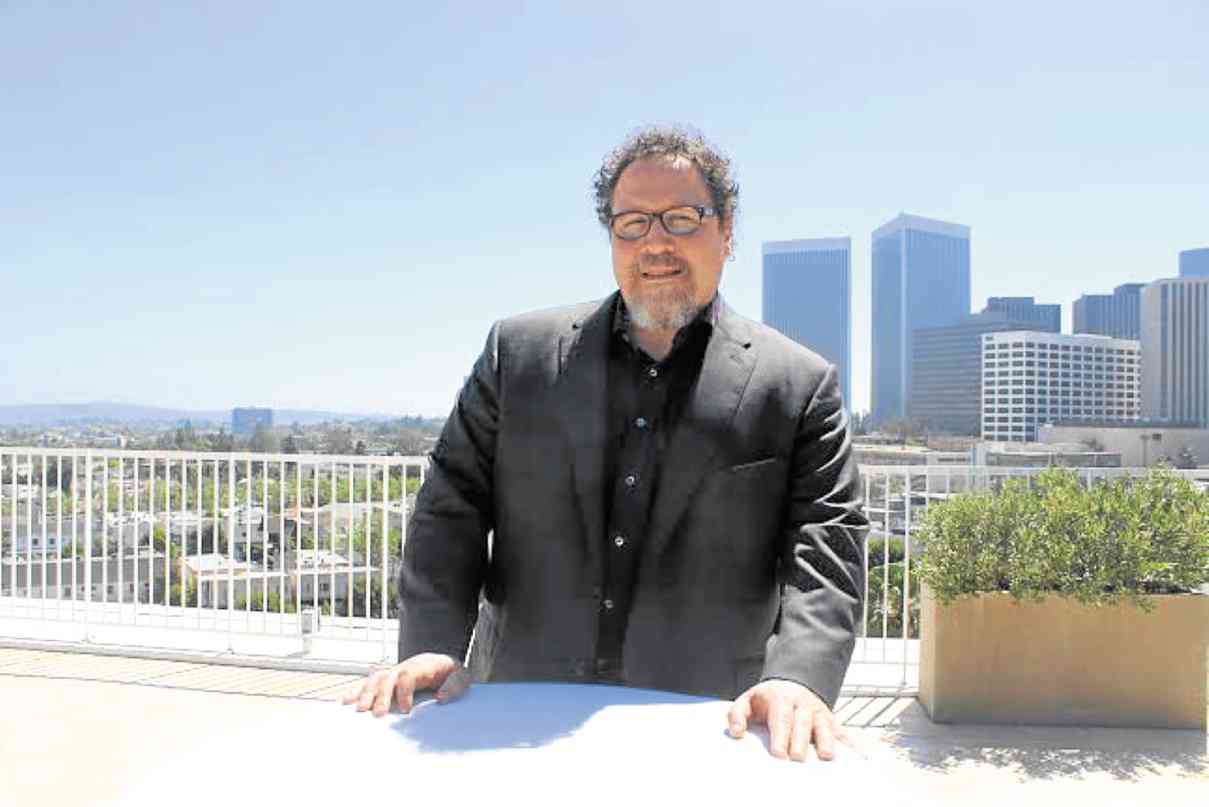Director reveals the secret to ‘The Jungle Book’s’ success

DIRECTOR Jon Favreau (rightmost) with three of his actors, from left: Ben Kingsley, Neel Sethi and Lupita Nyong’o
LOS ANGELES—Talking to Jon Favreau made me hungry. Even though the director was discussing “The Jungle Book,” his acclaimed live-action adaptation of Rudyard Kipling’s stories, he often brought up cooking analogies. It’s a leftover, so to speak, from directing, writing and starring as a food truck chef in, well, “Chef.”
Take, for example, Jon’s explanation of one of the elements that made “The Jungle Book” a triumph: “It’s like a chef picking an ingredient. If you see a perfect heirloom tomato, I know I can make a great salad out of that tomato. But as any chef will tell you, you can’t just give a chef any ingredient. They’re not going to make a great meal.
“Sometimes, that’s what gets lost in the Hollywood system—they’ll impose choices upon you. It’s hard to make something great if you don’t feel connected to the ingredients. But with the voice cast that I picked, I felt I had the pick of my first choices.”
The filmmaker behind the first two “Iron Man” movies, “Swingers” and “Elf” came up with a, er, delicious voice cast, indeed: Bill Murray, Christopher Walken, Idris Elba, Ben Kingsley, Scarlett Johansson and Lupita Nyong’o.
In our chat, Jon also talked about finding the main ingredient that greatly enhanced his film: the wonderful Neel Sethi as Mowgli, the only human actor on the screen. The father of three young kids with his doctor wife, Joya Tillem, also talked about the artistic and technological aspects that made “The Jungle Book” a visual masterpiece.
Excerpts from our interview:
Neel Sethi is a good find. What did you see in him right away that made you cast him?
If there’s one thing I’m very good at, it’s recognizing talent in people in front of and behind the camera. If you like my movies, most of it could be attributed to the cast that I picked. I’m pretty confident that I know it when I see it.
When Neel auditioned from Manhattan and put himself on tape, I kept watching the tape over and over again. He was the 2,000th kid we looked at, so I was getting scared I wasn’t going to find somebody.
First and foremost, you have to have somebody you’re willing to watch for an hour-and-a-half and you’re not going to get tired of. That’s a lot to ask of an adult actor, let alone a kid.
Sometimes, kids could get on your nerves if they aren’t good actors. Neel was very natural. Because we recorded the sound, then I motion-captured the entire film like you would on “Avatar,” it was almost like a rehearsal process for several months.
So, by the time we actually filmed Neel, we had a good shorthand. I have three kids. I know how to talk to kids. You don’t dumb down the conversation. They’re smarter than you think.
Neel just stepped up and did it. I knew I’d have the editing room. I just needed moments, sparks of honesty. I didn’t need him to be perfect in every take. It wasn’t a TV show or a play, where he had to do everything in front of an audience.
It was very personal. Sometimes, it was him and me. I had puppets made by Jim Henson Studios, anything I could do to keep the spark going and keep him from being bored, because he’s an energetic kid. He’s an athlete. We trained him how to do acrobatics and Parkour.
So, it was a really fun nine months for the kid, but it was a lot of work, and he matured into it. I was very lucky or smart to get this guy, because the whole movie hangs on him.
Did Neel, being young, sometimes lose his concentration?
That’s why we had the puppets. I’m an actor, so sometimes I’d be performing with him. Sometimes, we’d have other actors, as well. They’d paint me or the other actors out.
Can you talk about the score?
The score is something I’m particularly fond of. The key to it is a guy named John Debney, a composer I met for the first time on “Elf.” He grew up on the Disney lot. His father (producer Louis Debney) worked on “Snow White and the Seven Dwarfs.” Louis knew Walt (Disney).
John learned when he was little, watching the Sherman Brothers compose, so he was a child of this culture. He played on the lot with the little boy who did the voice of Mowgli in the original.
When you have a project like “The Jungle Book,” do you bounce your ideas off your kids?
I did. The original treatment was very much based on the Kipling stuff. When I went home to my kids, I was telling them the story and noticed when they engaged or disengaged, what they got excited about. The more it was like the ’67 film, the more they sparked.
There was no music at one point when we were developing the movie. When my kids were seeing rough pencil versions, “The Bare Necessities” was going to be in the end credits, not in the body of the film. They were disappointed. They were like, “Where’s the song?” I was like, “It’s a different version.” They were like, “No!” I know enough to listen to them.
What were the elements that you felt you could work with that made this film special?
I thought the combination of the old stories with the new technology has been a secret formula in Hollywood for a long time. It was George Lucas’ secret. They’ve said this—you use the old myths, the Joseph Campbell stories, then you put cutting edge technology. I’d say the same thing with “Avatar.”
Walt Disney always used that trick. To me, there was a great opportunity when I saw that Disney was feeling confident in its old titles being made into live action films.
The success of “Cinderella,” “Maleficent” and “Alice in Wonderland” allowed me to know that I would have the resources to actually use this technology. I knew I could build a world—that’s my favorite part of the gig.
I like to create worlds and put a cast together. Then, you step back, let great artists and actors work together and watch all of this unfold.
Can you talk about the vastly improved technology that helped you create this visually stunning film?
Fortunately, the film industry is generous with its ideas. As long as filmmakers have already done it, they’re happy to share with you what they did. They’re not possessive.
For example, Jim Cameron, who developed a lot of this technology for “Avatar” like Simulcam, the Pace photography system, where you’re filming 3D, the motion-capture technology, all those things—he really had to carve that out of nothing. And Rob Legato, visual effects supervisor, also did that.
We’re building on the shoulders of other filmmakers and also very much on what Pixar and Disney Animation does. Because if you look at the front end of our movie, we did this as you would a Pixar film up until when we filmed the motion-capture of Mowgli.
What was the hardest part for you?
These are artists working with tools. It isn’t a computer doing it; these are people who, instead of getting a paint brush, a cel and paint, are sitting at a monitor with a mouse or tablet. But they’re drawing, animating, doing everything that would have been done before.
Overseeing and inspiring other artists as a director was my job on this film, because I couldn’t do it myself.
Each shot as you look at them, you’ll see details. I’m not talking about what’s in the foreground. I’m talking about the animals in the deep background that are behaving in a certain way, because I would show them references of another movie. We’d watch a scene from a (Akira) Kurosawa film, a Western or a scene from “Bambi.”
We’d look at photography from films like “Never Cry Wolf” or “The Black Stallion.” We looked at movies that had nothing to do with CGI (computer-generated imagery) or the story, but just the photography.
I felt like a small part of a bigger machine, a big team. This was a wonderful experience for me.
E-mail [email protected]. Follow him at https://twitter.com/nepalesruben.















